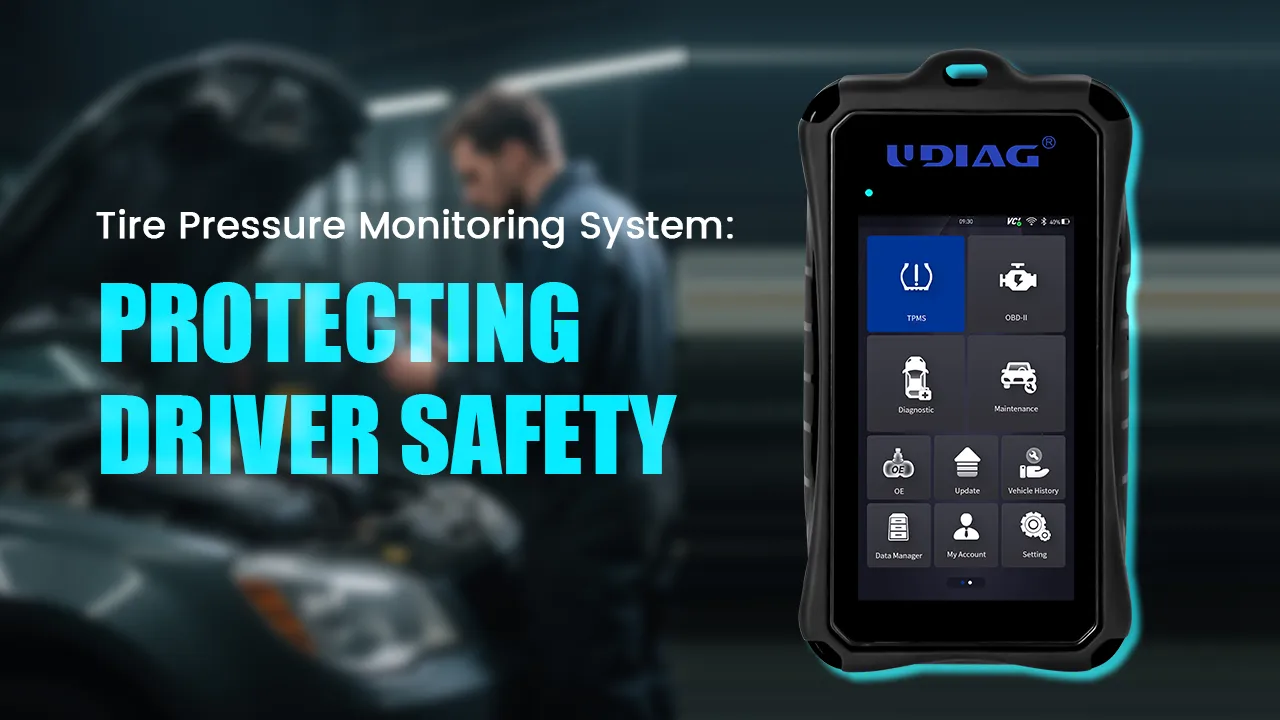Tire Pressure Monitoring System: Protecting Driver Safety
2025-08-13 by UDIAG

Introduction:
When you think of underinflated tires, what comes to mind? Blowouts, complicated tire-changing procedures, or shipment delays? While these issues themselves are frustrating, the hidden risks are far more serious. In fact, tens of thousands of traffic accidents related to tire safety occur each year. Insufficient tire pressure not only compromises driving safety, but also has far-reaching consequences. Studies show that for every 1 PSI decrease in tire pressure, a vehicle’s fuel efficiency decreases by 0.3%. Not to mention the additional costs associated with tire replacements, repairs, and labor costs associated with blowouts.
With the right tire pressure monitoring system, you can prevent potential problems before they occur. Manually checking tire pressure, by contrast, requires stopping the vehicle and using a tire pressure gauge, a process that can be tedious and inaccurate, especially on larger vehicles with many tires.
Fortunately, there’s a convenient and efficient way to monitor tire pressure: a tire pressure monitoring system (TPMS). In this blog, you’ll learn more about what TPMS is, how it works, its different types, its specific benefits, and the potential costs of replacing the sensors. Join us as we explore the secrets of this technology and see how it can easily help ensure safer driving and save you money in the long run.
What is a Tire Monitoring System?
A tire monitoring system, also known as a tire pressure monitoring system (TPMS), is an electronic device used in vehicles that alerts the driver when the pressure in at least one of the tires drops to a dangerous level (usually below 25% of the recommended value).
Think of this system as a dedicated tire management assistant, designed to help drivers maintain ideal tire pressure, thereby improving driving safety, reducing fuel consumption, and extending tire life. Technically, a monitoring system should detect both tire pressure and temperature, and TPMS, as a subset of this system, primarily focuses on pressure monitoring. However, in the automotive industry, the two terms are often used interchangeably, mostly referring to the pressure monitoring function.
To improve road safety, all newly sold vehicles are now required to be equipped with tire pressure monitoring systems. Combining TPMS with modern telematics solutions enables real-time tracking of tire pressure, regardless of location. It also enhances overall supply chain visibility, providing users with true peace of mind.
Benefits of Tire Pressure Monitoring Systems
There are several benefits to using a TPMS, including improved safety, increased fuel efficiency, longer tire life, reduced maintenance costs, and regulatory compliance.
Enhanced Security
Proper tire pressure is crucial for optimal braking performance, handling, and driving stability. Insufficient tire pressure can cause damage or a blowout, increasing the risk of loss of vehicle control and potentially leading to a serious accident. A Tire Pressure Monitoring System (TPMS) allows you to check tire pressure at all times and take appropriate action if the system issues an alarm.
Improve Fuel Efficiency
Keeping your tires within the correct pressure range not only improves fuel efficiency but also maximizes your vehicle’s mileage, helping you effectively reduce your daily fuel expenses.
Longer Tire Life
Insufficient tire pressure causes uneven wear, further shortening the lifespan of your tires. A Tire Pressure Monitoring System (TPMS) helps you maintain ideal tire pressure, ensuring even wear, extending tire life, and saving drivers money in the long run.
Reduce Maintenance Costs
Adequately inflated tires are easier to maintain than underinflated ones. Using a tire pressure monitoring system (TPMS) to monitor tire pressure in real time can effectively reduce the frequency of tire replacements and extend the life of your vehicle. Simply put, installing a TPMS not only reduces maintenance costs in the long run, but also reduces the hassle of frequent tire changes.
Regulatory Compliance
Modern cars must be legal to operate on the road. For example, the United States has mandated that all new cars be equipped with a tire pressure monitoring system (TPMS) since September 2007. By installing a TPMS, drivers can not only comply with relevant regulations but also avoid penalties for violations.
Types of TPMS
There are two main types of TPMS based on how they measure tire pressure: direct TPMS and indirect TPMS.
Indirect TPMS
If you’re looking for an affordable tire pressure monitoring system, an indirect tire pressure monitoring system might be the right choice for you. This system monitors the relative rotational speed of the tires to determine if they are underinflated.
When a tire is underinflated, its diameter is reduced, causing it to rotate faster than a properly inflated tire. The indirect tire pressure monitoring system uses the ABS sensors to compare the rotational speeds of each tire and detect if any tire is exhibiting abnormal rotational speed.
Compared to direct tire pressure monitoring systems, indirect TPMS offers the advantage of requiring no additional sensors, such as pressure sensors, making it less expensive. However, this system has limited accuracy—it cannot fully monitor the inflation status of all tires at once. Furthermore, indirect TPMS will only detect and report low tire pressure if there is a significant difference in tire rotational speed.
Nevertheless, for those seeking a simple and cost-effective solution, indirect tire pressure monitoring remains a practical option worth considering.
Direct TPMS
As the name suggests, a direct tire pressure monitoring system (TPMS) monitors tire pressure in real time using pressure sensors installed inside each tire. These sensors wirelessly transmit the measured data to the vehicle’s computer system.
The system will continuously analyze this data, and if it finds that the tire pressure of a tire is below the safe range, it will alert the driver through the warning light on the dashboard.
Direct TPMS offers significant advantages in detection accuracy over indirect TPMS. It not only accurately identifies low and high pressure conditions but also monitors the pressure of each tire independently. This allows it to detect problems even if all tires are simultaneously underinflated, something indirect TPMS typically cannot do.
However, despite its superior reliability, direct TPMS has some drawbacks. First, it’s more expensive to install and maintain. The pressure sensors themselves are expensive, and they typically run on batteries that need to be replaced once they’re depleted. Overall, direct TPMS is a more accurate and reliable option for tire pressure monitoring, but it also comes at a higher cost.
What Tools can be Used to Diagnose Tire Pressure Monitoring Systems?
It goes without saying that you must always maintain your vehicle’s recommended tire pressure levels to ensure the safety of the driver and other vehicles on the road, not to mention saving costs and increasing productivity. Therefore, having a reliable tire pressure monitoring system (TPMS) diagnostic tool is crucial.
UDIAG X-20 is a professional TPMS diagnostic scan tool that supports 99% of sensors (315MHz/433MHz) for global vehicles. This all-in-one TPMS service tool performs sensor programming, cloning, activation, and OBD relearns with auto sensor detection. Features full OBD2 diagnostics (DTC scan/clear) plus tire pressure reset functions. Its 5.5-inch color display and multilingual interface ensure easy operation. With free lifetime updates, it’s the perfect tire pressure tool for auto workshops and tire specialists seeking fast, accurate TPMS service solutions.
Conclusion
Whether you’re a DIY enthusiast or a body shop, investing in a TPMS scan tool is a wise decision because it not only improves the safety of the driver, passengers, and other road users, but also saves money by improving fuel efficiency and extending tire life. UDIAG X-20 professional TPMS diagnostic scan tool. If you are interested, please feel free to contact us.
FAQs
Q: How many years of updates does the X-20 TPMS scanner include?
A: Lifetime Free Updates. Ensures your tool remains up-to-date with the latest sensors and vehicle protocols. This feature provides long-term value by keeping your diagnostics capabilities at the forefront of automotive technology.
Q: Does the X-20 TPMS scanner have other functions?
A: Of course, It also Integrate the most useful 10 service functions: ABS bleeding, BRT, TPMS, DPF, EPB, injector coding, oil reset, SAS, clutch adaptation and change tire.
Q: How Much does it Cost to Replace a TPMS Sensor?
A: If you’re wondering how much it costs to replace a TPMS sensor, the answer is that it depends on several factors—such as the type of vehicle, sensor brand, and the location of the repair shop. Different vehicle types may require sensors of varying quality. For example, heavy-duty trucks and trailers require more rugged sensors to withstand harsh environments. Therefore, sensor replacement costs for these vehicles may be higher than for lighter vehicles.
Q: Is the “Low Tire Pressure” Warning the Same as TPMS?
A: People often confuse the tire pressure light with the tire pressure monitoring system (TPMS) light. However, these two lights indicate different issues with the tire monitoring system. The tire pressure light (a horseshoe-shaped light with an exclamation point in the middle on the dashboard) indicates that one of the tires is significantly below the recommended level. On the other hand, the TPMS light (usually displayed as the letters “TPMS” on the dashboard) turns off when there’s a problem with the tire monitoring system, such as a faulty sensor or a problem with the monitor.


